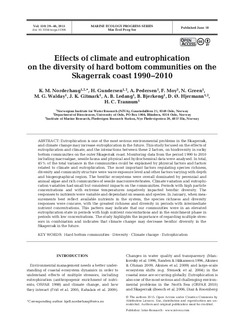| dc.contributor.author | Norderhaug, Kjell Magnus | |
| dc.contributor.author | Gundersen, Hege | |
| dc.contributor.author | Pedersen, Are | |
| dc.contributor.author | Moy, Frithjof Emil | |
| dc.contributor.author | Green, Norman Whitaker | |
| dc.contributor.author | Walday, Mats Gunnar | |
| dc.contributor.author | Gitmark, Janne Kim | |
| dc.contributor.author | Ledang, Anna Birgitta | |
| dc.contributor.author | Bjerkeng, Birger | |
| dc.contributor.author | Hjermann, Dag Øystein | |
| dc.contributor.author | Trannum, Hilde Cecilie | |
| dc.date.accessioned | 2018-09-13T11:42:07Z | |
| dc.date.available | 2018-09-13T11:42:07Z | |
| dc.date.created | 2015-10-10T20:17:42Z | |
| dc.date.issued | 2015 | |
| dc.identifier.citation | Marine Ecology Progress Series. 2015, 530 29-46. | nb_NO |
| dc.identifier.issn | 0171-8630 | |
| dc.identifier.uri | http://hdl.handle.net/11250/2562505 | |
| dc.description.abstract | Eutrophication is one of the most serious environmental problems in the Skagerrak, and climate change may increase eutrophication in the future. This study focused on the effects of eutrophication and climate, and the interactions between these 2 factors, on biodiversity in rocky bottom communities on the outer Skagerrak coast. Monitoring data from the period 1990 to 2010 including macroalgae, sessile fauna and physical and hydrochemical data were analysed. In total, 45% of the total variance in the communities could be explained by physical factors and factors related to climate and eutrophication. The most important factors regulating species richness, diversity and community structure were wave exposure level and other factors varying with depth and biogeographical region. The benthic ecosystems were overall dominated by perennial and annual algae and rich communities of sessile macroinvertebrates. Climate variation and eutrophication variables had small but consistent impacts on the communities. Periods with high particle concentrations and with extreme temperatures negatively impacted benthic diversity. The responses to nutrients were variable and dependant on season and species. In January, when measurements best reflect available nutrients in the system, the species richness and diversity responses were concave, with the greatest richness and diversity in periods with intermediate nutrient concentrations. This pattern may indicate that our communities were in an elevated eutrophication state in periods with high nutrient concentrations and in the enrichment phase in periods with low concentrations. The study highlights the importance of regarding multiple stressors in combination and indicates that climate change may decrease benthic diversity in the Skagerrak in the future. | nb_NO |
| dc.language.iso | eng | nb_NO |
| dc.title | Effects of climate and eutrophication on the diversity of hard bottom communities on the Skagerrak coast 1990-2010 | nb_NO |
| dc.title.alternative | Effects of climate and eutrophication on the diversity of hard bottom communities on the Skagerrak coast 1990-2010 | nb_NO |
| dc.type | Journal article | nb_NO |
| dc.type | Peer reviewed | nb_NO |
| dc.description.version | publishedVersion | nb_NO |
| dc.source.pagenumber | 29-46 | nb_NO |
| dc.source.volume | 530 | nb_NO |
| dc.source.journal | Marine Ecology Progress Series | nb_NO |
| dc.identifier.doi | 10.3354/meps11306 | |
| dc.identifier.cristin | 1279757 | |
| dc.relation.project | Norges forskningsråd: 208279 | nb_NO |
| dc.relation.project | Norges forskningsråd: 179569 | nb_NO |
| cristin.unitcode | 7431,28,0,0 | |
| cristin.unitname | Bunnsamfunn og kystinteraksjon | |
| cristin.ispublished | true | |
| cristin.fulltext | original | |
| cristin.qualitycode | 2 | |
